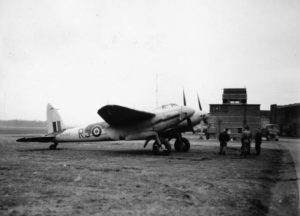This twin-engined British aircraft was made almost entirely out of wood and served many roles in combat, among them as a night fighter. In comparison to the American P-61 night fighter, it was proven to be better, in some respects (speed), and worse in others (rate of climb, turning radius).
Tom writes on July 3, 1944, that as a night fighter pilot, he might be assigned to fly the Mosquito because “the P-61 isn’t proving to be too good”.

Excerpt from Wikipedia:
The de Havilland DH.98 Mosquito is a British twin-engine shoulder-winged multi-role combat aircraft, introduced during Second World War. It was one of few operational front-line aircraft of the era whose frame was constructed almost entirely of wood, and was nicknamed The Wooden Wonder,[4] and affectionately as “Mossie” to its crews.[5][nb 1]
When Mosquito production began in 1941 it was one of the fastest operational aircraft in the world.[7] The first variant was an unarmed, high-speed, high-altitude photo-reconnaissance aircraft. Originally conceived as an unarmed fast bomber, the Mosquito’s use evolved during the war into many roles including low to medium-altitude daytime tactical bomber, high-altitude night bomber, pathfinder, day or night fighter, fighter-bomber, intruder, maritime strike aircraft. It was also used by the British Overseas Airways Corporation (BOAC) as a fast transport to carry small high-value cargoes to, and from, neutral countries, through enemy-controlled airspace.[8] The crew of two, pilot and navigator, sat side by side, but a single passenger could ride in the aircraft’s bomb bay when necessary.[9]
